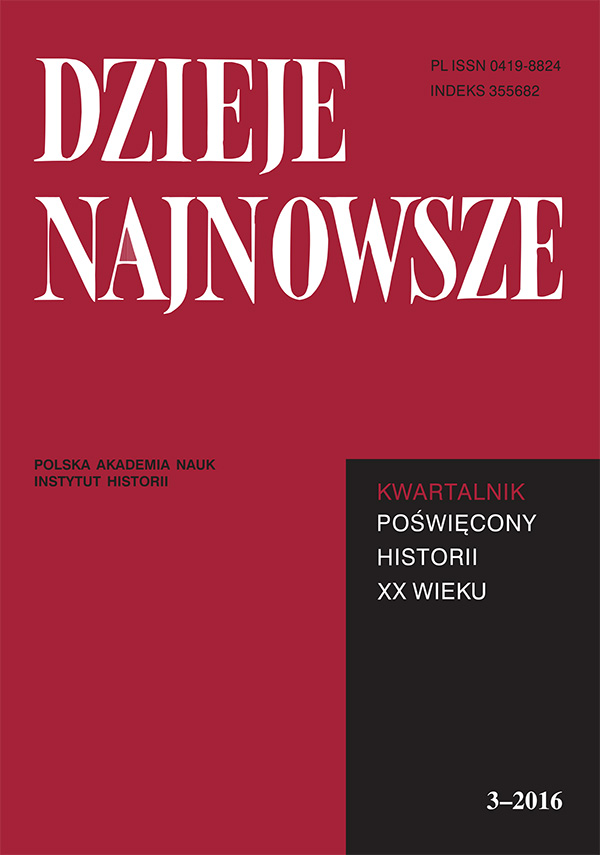Kolczasty drut śmierci jako strażnik granicy. Nieznany epizod Wielkiej Wojny 1914–1918 na pograniczu holendersko-belgijskim
DOI:
https://doi.org/10.12775/DN.2016.3.02Słowa kluczowe
granica, drut kolczasty, enklawa, Belgia, Holandia, BrabancjaAbstrakt
The Wire of Death as a Border Guard. An Unknown Episode of the Great War 1914–1918 along the Dutch–Belgian Frontier
For four long years the First World War changed the relations between the Kingdom of The Netherlands and the Kingdom of Belgium, with the former remaining neutral in the conflict while the latter became a theatre of particularly bloody hostilities. In the province of North Brabant, which was part of the Kingdom of The Netherlands, at a small distance from border with the Kingdom of Belgium there lies a locality bearing the double name of Baarle–Hertog and Baarle–Nassau – a Dutch–Belgian jigsaw composed of 30 enclaves. The German armies decided not to attack the Belgian enclaves since they could not do so without violating the neutrality of the Dutch. In order to prevent the inflow into The Netherlands of volunteers who could come to the aid of the army defending itself in the Yzer river valley, in January 1915 the German troops embarked upon setting up networks of barbed wire along the entire Belgian border (450 kms long) from the Zwin inlet in Knokke to the suburbs of Aix–la–Chapelle. The unique frontier encircling the Belgian enclaves was composed of electric barbed wire known as the „Wire of Death”, which took the lives of numerous victims and was the source of the tragic plight of all thus separated families. The border in question also divided small towns and villages, sometimes in half. The presented text discusses several such instances. The author concentrated predominantly on the functioning of the lethal frontier and the life of people residing on both its sides. He also described the history of Baarle–Hertog, a little– known fragment of free Belgium within Dutch Branat, and its role in obtaining information about the plans and activity of the German occupant.
Bibliografia
Baarle in stukken. Fragmenten uit het verleden van Baarle, Casterlé, Ulicoten en Zondereigen, red. J. Jansesn, A. van Tijl, A. van Solms, Baarle–Hertog–Nassau 1992.
En Territoire Belge et à Quarante Centimètres de la Frontière. An historical and documentary study of the Belgian and Dutch enclaves of Baarle–Hertog and Baarle–Nassau, w: Research paper published by The Schol of Anthropology, Geography and Environmental Studies, The University of Melbourne, Vic 3010, Melbourne 2014.
Hoogspanning aan de Belgisch–Nederlandse grens. De Eerste Wereledoorlog aan de rijksgrens me Baarle, red. H. Janssen, Heemkundekring, A. van Solms, Baarle–Hertog–Nassau 2013.
Joosen H., Ons Baarle een bijzoder dorp. Bouwstenen voor de geschledenis van Baarle, Baarle–Nassau 2006.
Schaepdrijver S., De Groote Oorlog. Het Koninkrijk België tijdens de Eerste Wereld Oorlog, Antwerpen 2013.
Whyte B. R., Listening to Ludendorff. A Clandestine Belgian Military Wireless Station Behind German Lines 1915–1919, pamiętnik P. Goldschmidta, przekład i wstęp B. Whyte, Brighton 2013.
Vandenbussche S., Wereldoorlog 1 in de Westhoek, „België onder de bezetting” [pdf] 2012. Żelichowski R., Baarle–Hertog–Nassau, Seria: Europa w skali mikro, Warszawa 2015.
Pobrania
Opublikowane
Jak cytować
Numer
Dział
Statystyki
Liczba wyświetleń i pobrań: 370
Liczba cytowań: 0



